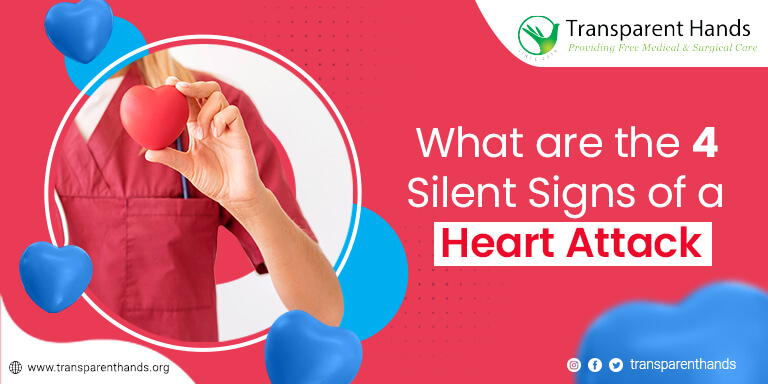What are the 4 Silent Signs of a Heart Attack

What is a Heart Attack?
Myocardial infarction, more commonly known as a heart attack, is a life-threatening condition caused by a disruption in blood supply to the heart muscle. A blockage in one or more of your heart’s arteries is the most common cause of inadequate blood supply. The affected heart muscle will begin to die without adequate blood supply. A heart attack can cause permanent heart damage or death if blood flow isn’t restored quickly. We’ll discuss the 4 silent signs of a heart attack in this article and will discuss how to prevent heart attacks.
Causes of a Heart Attack
The most common causes of a heart attack are:
- Coronary artery disease occurs when the arteries that supply blood to the heart narrow or become blocked due to plaque buildup.
- High blood pressure can cause the arteries to narrow and become less elastic, making it difficult for blood to flow through them.
- Tobacco use harms the lining of the blood vessels and can cause them to narrow, increasing the risk of a heart attack.
- High LDL (bad) cholesterol levels can lead to plaque buildup in the arteries, increasing the risk of a heart attack.
- Diabetes can harm the blood vessels and nerves that control the heart, raising the risk of a heart attack.
- Obesity increases the risk of developing other risk factors for heart disease, such as high blood pressure and high cholesterol.
- A family history of heart disease can increase the risk of getting a heart attack.
Symptoms of a Silent Heart Attack
A heart attack is a life-threatening emergency. If you or someone around you experiences any of the following symptoms, seek medical attention immediately.
1. Chest Pain or Discomfort
The most common symptom of a heart attack is chest pain or discomfort. This may feel like pressure, tightness, or a squeezing sensation in the chest. The pain may also radiate to the arms, neck, jaw, back, or stomach.
2. Shortness of Breath
Another common symptom of a heart attack is shortness of breath. This may occur with or without chest pain and may be accompanied by a feeling of tightness in the chest or difficulty breathing.
3. Sweating
Sweating or breaking out in a cold sweat can signify a heart attack. This symptom is more common in women than in men.
4. Fatigue
Feeling unusually tired or fatigued can also be one of the symptoms or silent signs of a heart attack. This may occur in the days or weeks leading up to a heart attack and is often more common in women than men.
Signs of Heart Attack in Women
Silent Signs of a Heart Attack
It’s important to note that not all heart attacks present with the classic symptoms of chest pain or discomfort. Some heart attacks can be “silent,” which means there are no obvious signs.
This is why it’s important to be aware of the 4 silent signs of a heart attack:
1. Nausea or Vomiting:
Nausea or vomiting can be a sign of a heart attack, particularly in women. This symptom may occur with or without chest pain and may be accompanied by sweating shortness of breath, or fatigue.
2. Jaw Pain:
Jaw pain can be a sign of a heart attack, particularly in women. This may occur with or without chest pain and may be accompanied by shortness of breath, sweating, or fatigue.
3. Indigestion or Heartburn:
Indigestion or heartburn can be a sign of a heart attack, particularly in men. This may occur with or without chest pain and may be accompanied by shortness of breath, sweating, or fatigue.
4. Arm Pain:
Arm pain can be a sign of a heart attack, particularly in women. This may occur with or without chest pain and may be accompanied by shortness of breath, sweating, or fatigue.
Preventing Heart Attacks
Preventing a heart attack begins with making healthy lifestyle choices. This includes eating a healthy diet, exercising regularly, staying at a healthy weight, and not smoking. Chronic conditions such as high blood pressure, high cholesterol, and diabetes must also be managed to contain even the silent signs of a heart attack. Talk to your doctor about ways to reduce your risk if you have a family history of heart disease or other risk factors such as age, gender, or race. Aside from lifestyle changes, medical treatments can also help prevent a heart attack. This may include medications to lower cholesterol, blood pressure, or blood sugar, as well as procedures to open blocked arteries, such as angioplasty or bypass surgery.
If you or someone you know has had a heart attack, it’s important to make lifestyle changes and follow the recommended medical treatments to reduce the risk of another heart attack. This could mean taking part in a cardiac rehabilitation program, which uses exercise, education, and support to help improve heart health.










Leave Your Comments